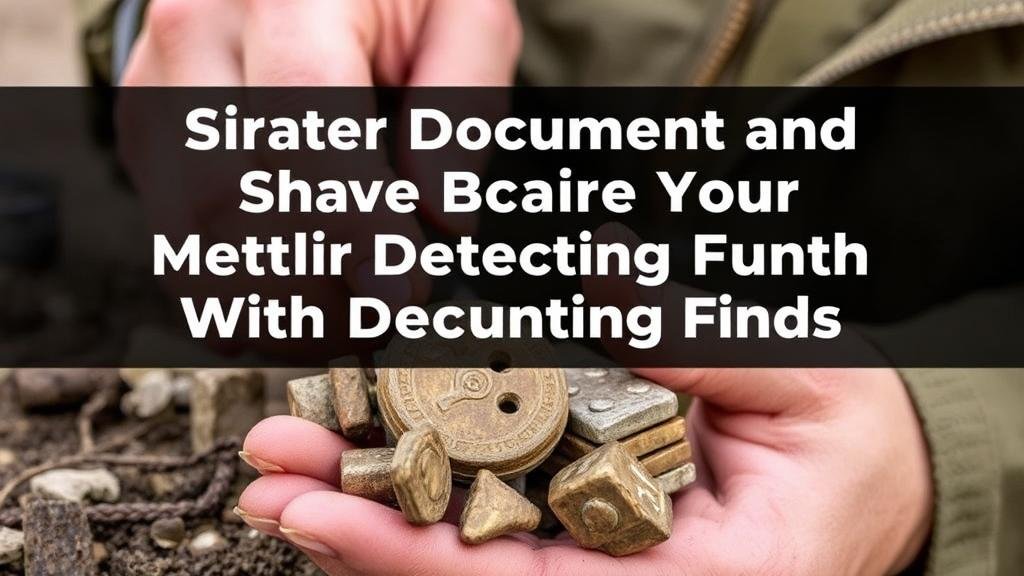How to Document and Share Your Metal Detecting Finds With the Community
How to Document and Share Your Metal Detecting Finds With the Community
Metal detecting has surged in popularity, becoming a favored hobby for many individuals interested in archaeology, history, and outdoor activities. One of the key components to enriching the metal detecting community is the effective documentation and sharing of finds. This article offers detailed guidance on how to document and share your metal detecting discoveries, fostering a supportive community environment.
The Importance of Documentation
Documentation serves as the backbone of responsible metal detecting practices. Properly documenting your finds ensures that valuable historical and archaeological data is preserved and accessible for future generations.
- Historical Insight: Each item uncovered can provide insights into past cultures, economies, and daily life. For example, the discovery of a 19th-century coin can reveal information about trade practices in that era.
- Record Keeping: Detailed records establish a timeline of discoveries, including location, depth, and context, which can be beneficial for both personal reflection and scholarly analysis.
Essential Documentation Techniques
To effectively document your metal detecting finds, consider the following methods:
- Take High-Quality Photos: Photographs should include images of the item from multiple angles, alongside images of the location where it was found.
- Use a Finds Notebook: Record details like the date of discovery, GPS coordinates, depth, and type of detector used. Also, note any comments about the condition of the item.
- Use Digital Tools: Applications like Evernote or Google Sheets can facilitate organized tracking and cataloging of finds.
For example, a metal detector enthusiast who discovers a World War II dog tag can document its precise location and depth, photograph it in its uncleaned state, and make notes about the surrounding area that could help establish a larger narrative about local history.
Creating a Presentation Plan
Once your finds are documented, sharing them with the community is the next step. An effective presentation plan is crucial. Here are several approaches to consider:
- Social Media Platforms: Utilizing platforms such as Instagram and Facebook allows for easy sharing and interaction. Regularly update your followers with stories about each find.
- Forums and Blogs: Dedicated metal detecting forums or personal blogs can serve as excellent platforms for in-depth discussions regarding your finds, including techniques used in recovery and research on the items background.
- Local Clubs and Meetups: Present findings at local metal detecting clubs or events, encouraging discussion and knowledge sharing amongst enthusiasts.
For example, joining a local metal detecting club allows you to share your finds in person, receive feedback, and even collaborate on joint research projects about historical contexts related to the finds.
Engaging with the Community
Engagement is key to building a thriving metal detecting community. Here are some tips to foster interaction:
- Ask Questions: Encourage discussions by seeking insights from others about your finds, such as their origin and historical significance.
- Share Knowledge: Offer tips on the techniques you use for successful detection or how to clean and preserve items.
- Highlight Community Member Contributions: Feature finds from others in your updates to foster inclusivity and encourage broader participation.
In a real-world application, participating in community events such as metal detecting days can provide invaluable firsthand knowledge and promote collaboration among enthusiasts.
Ethical Considerations in Metal Detecting
Responsibility and ethics are paramount when documenting and sharing finds. It is essential to adhere to local laws and regulations regarding metal detecting. Always seek permission before searching on private property, and report significant historical finds to the relevant authorities. e practices ensure that the hobby remains respected and sustainable.
- Respect Historical Sites: Avoid detecting in protected areas or archaeological sites without permission.
- Follow the Code of Conduct: Many clubs and organizations promote a code of ethics which includes respecting the land and returning items to proper authorities when necessary.
Actionable Takeaways
To wrap up, effectively documenting and sharing your metal detecting finds can significantly enrich your experience and contribute positively to the community. Here are key actions to consider:
- Document every find meticulously, from location to condition.
- Share your discoveries through social media, forums, and local clubs.
- Engage with fellow enthusiasts by asking questions and sharing knowledge.
- Maintain ethical standards in your exploration and reporting.
By following these guidelines, you not only enhance your metal detecting journey but also contribute to a knowledge-rich community, ensuring that the past continues to inform the future.



